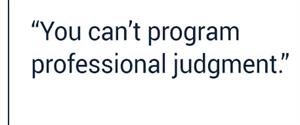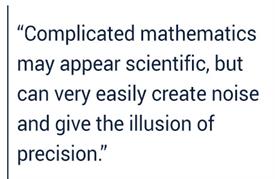BVR’s Cost of Capital Professional: What the experts behind this new platform have to say
BVR is excited to announce the release of its new Cost of Capital Professional platform, a state-of-the-art resource that provides a simple and transparent way to estimate cost of capital. This new platform supports BUM and CAPM calculations for any valuation date and is currently available on a free trial basis to all practitioners until December 31. BVR’s intent is to provide a simple, independent service to augment each appraiser’s own judgment and his or her other cost of capital research.
BVR recently sat down with two of the individuals involved in the development of the new platform for a comprehensive Q&A. The author of the platform, Dr. Michael Crain, has been a practitioner for over 30 years and is also an academic. He holds several professional certifications (CPA/ABV, CFA, CFE) and received his Doctor of Business Administration (finance) degree from Manchester Business School in England at the University of Manchester. Dr. Crain is a faculty member at Florida Atlantic University and director of FAU’s Center for Forensic Accounting and continues to consult with clients as a senior advisor to Miami-based Kaufman Rossin, a top-100 accounting firm.
Ronald L. Seigneur, co-chair of the Cost of Capital Professional advisory board, holds several credentials (ASA, CPA/ABV, CVA), and is managing partner of Seigneur Gustafson LLP CPAs, based in Lakewood, Colo., where he is responsible for financial forensics, economic damages assessments, business and intellectual property valuation, exit planning, and related litigation support services. He is a frequent speaker and author on valuation, economic damages, leadership, and other professional firm practice management topics and is in the AICPA Business Valuation Hall of Fame.
BVR: Why does the profession need a new platform for estimating the cost of capital?
Michael Crain (MC): We’ve reached the point where the concept and the inputs to cost of capital have become so complex that the risk of making errors has increased. Finance is not a physical science; it’s a social science. Tools of physical science and mathematics are probably being incorrectly applied, and the process has become too much of a black box of applied mathematics. Mathematics should be used as a tool in practice. It should be a means to an end, not the end itself. Focusing too much on math results in an “illusion of precision” that moves us away from using judgment in the process. You can’t program professional judgment.
 Ronald Seigneur (RS): The new platform is designed to bring back flexibility to the process. That is, we give you the raw materials, and you use your professional judgment to shape the final result. You are not steered into a particular way of doing something. The platform will have certain default options, but you have the freedom to decide whether or not to use those options. We’re not using enough common sense anymore when it comes to cost of capital, so this platform brings more of that back into the process.
Ronald Seigneur (RS): The new platform is designed to bring back flexibility to the process. That is, we give you the raw materials, and you use your professional judgment to shape the final result. You are not steered into a particular way of doing something. The platform will have certain default options, but you have the freedom to decide whether or not to use those options. We’re not using enough common sense anymore when it comes to cost of capital, so this platform brings more of that back into the process.
BVR: Will the new platform address all of the components of the build-up method and CAPM?
MC: Yes. You will be able to develop the components either from data provided to practitioners or from their own input. In addition to using CRSP data from the University of Chicago, there is access to data Dr. Aswath Damodaran (New York University Stern School of Business) developed. The cost of equity capital platform provides information on risk-free rates, equity risk premiums, size premiums, and industry considerations.
RS: There is also a place for you to input company-specific risk so that you can develop a complete estimate for the cost of equity. For CAPM, the platform does not provide a beta, but there is a link to Dr. Damodaran’s data from which you can develop it.
BVR: How does the new platform reduce the complexities of estimating a firm’s cost of capital?
MC: We use the “less is more” approach to think about cost of capital and required returns in simpler, rather than more complex, ways. It embodies the idea that cost of capital estimates are just that—estimates—and are not precise calculations to  the nth decimal. We cannot actually observe investor expected returns (cost of capital) because investor expectations are unobservable. Even if we could observe them, they change quickly because of news. Instead of observation, practitioners use models to estimate, not calculate, cost of capital. Since ancient times, prominent scientists and philosophers have stressed the importance of simplicity in explaining things. This idea is called the principle of parsimony, or Occam’s razor. This principle essentially says that simpler solutions tend to be better than complex ones. This idea also stresses signal over noise. Our platform tries to collect signal, filter out noise, and give a better solution. Complicated mathematics may appear scientific, but it can very easily create noise and give the illusion of precision.
the nth decimal. We cannot actually observe investor expected returns (cost of capital) because investor expectations are unobservable. Even if we could observe them, they change quickly because of news. Instead of observation, practitioners use models to estimate, not calculate, cost of capital. Since ancient times, prominent scientists and philosophers have stressed the importance of simplicity in explaining things. This idea is called the principle of parsimony, or Occam’s razor. This principle essentially says that simpler solutions tend to be better than complex ones. This idea also stresses signal over noise. Our platform tries to collect signal, filter out noise, and give a better solution. Complicated mathematics may appear scientific, but it can very easily create noise and give the illusion of precision.
RS: The platform is based on the fundamental approach from the SBBI series that was used for many years. The new platform relies on the Center for Research in Security Prices (CRSP) market return data set, which is the most respected and widely used basis for 10-decile returns in practice and academia. The use of CRSP data has stood the test of time in a litigation setting where testifying experts are required to use reliable methods and principles. Also, because the process is less complex, it is more transparent. As a result, you don’t have to spend a lot of time explaining your methodology choices to clients or judges.
BVR: If one uses a simpler approach, will they spend less time developing a valuation?
MC: Perhaps, but that’s not the goal here. The new platform will help refocus your attention on where it needs to be in the valuation equation. That is, you will spend less time on the denominator, which includes cost of capital, and perhaps more time on the numerator, the cash flows.
RS: Even though this is a simpler, more fundamental approach, the bottom line is that this new platform is elegant. It gives you everything you need without all of the noise that other tools provide.
BVR: The profession already has solutions for estimating the cost of capital. Why would anyone consider this new platform?
MC: For the reasons we just talked about—and more. A major reason is that firms that are offering the other solutions also provide valuation services. This is a clear conflict of interest because, if you try to define the process or create complicated rules for estimating cost of capital—and you are profiting from it—there is no incentive to consider challenges to it based on newer findings. This discourages change and innovation. The solution other platforms provide also steers you into using the opinions of the provider, which may not have any independent academic basis. The new platform is based on academic research, not someone’s spin on the data or opinion of what is “normal.”
RS: Also, the solution provider you are currently using may be your competitor, which could make for a very uncomfortable position in a litigation setting.
BVR: You say a solution a player in the game provides could steer you into its way of thinking. Can you give an example?
MC: The size premium, for example. Some feel it is alive and well, and that opinion will be embodied in their computer algorithm for estimating cost of capital. Others believe the size premium has diminished or disappeared, but it depends on the time horizon of the data you use. If you look at the last 35 years, since Banz first documented the size premium in 1981, the size effect is very different than if you go all the way back to the 1920s. Our new platform gives you the control over the period of historical return data for your analysis. You can choose which time horizon (e.g., specific historical years) of data is appropriate for your case.
BVR: Are you interested in test driving this new platform? Sign up for a free trial.
BVR is offering the new Cost of Capital Professional platform on a free-trial basis until December 31. After that, it will be available with a subscription. Get more details on the platform with free article downloads, a comprehensive FAQ page, a free webinar, and a soon-to-be-released user guide.
We would love your feedback on this new resource for the business valuation profession! BVR, along with the advisory board made up of independent practitioners known for their experience with cost of capital, will review your comments to further enhance the platform.
